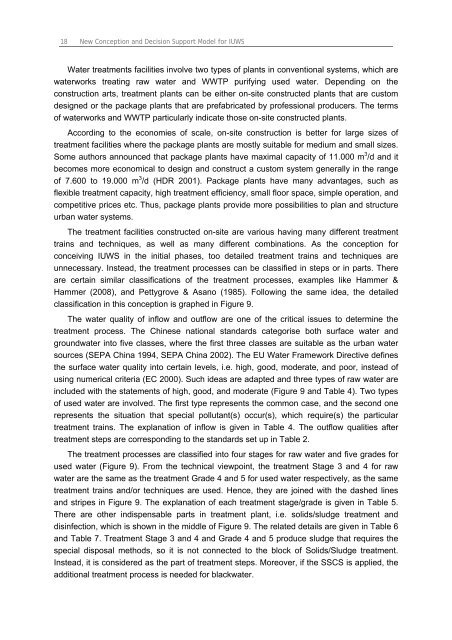Chapter 3 Decision Support Model (IUWS-DSM) - Tubdok
Chapter 3 Decision Support Model (IUWS-DSM) - Tubdok
Chapter 3 Decision Support Model (IUWS-DSM) - Tubdok
Create successful ePaper yourself
Turn your PDF publications into a flip-book with our unique Google optimized e-Paper software.
18 New Conception and <strong>Decision</strong> <strong>Support</strong> <strong>Model</strong> for <strong>IUWS</strong><br />
Water treatments facilities involve two types of plants in conventional systems, which are<br />
waterworks treating raw water and WWTP purifying used water. Depending on the<br />
construction arts, treatment plants can be either on-site constructed plants that are custom<br />
designed or the package plants that are prefabricated by professional producers. The terms<br />
of waterworks and WWTP particularly indicate those on-site constructed plants.<br />
According to the economies of scale, on-site construction is better for large sizes of<br />
treatment facilities where the package plants are mostly suitable for medium and small sizes.<br />
Some authors announced that package plants have maximal capacity of 11.000 m 3 /d and it<br />
becomes more economical to design and construct a custom system generally in the range<br />
of 7.600 to 19.000 m 3 /d (HDR 2001). Package plants have many advantages, such as<br />
flexible treatment capacity, high treatment efficiency, small floor space, simple operation, and<br />
competitive prices etc. Thus, package plants provide more possibilities to plan and structure<br />
urban water systems.<br />
The treatment facilities constructed on-site are various having many different treatment<br />
trains and techniques, as well as many different combinations. As the conception for<br />
conceiving <strong>IUWS</strong> in the initial phases, too detailed treatment trains and techniques are<br />
unnecessary. Instead, the treatment processes can be classified in steps or in parts. There<br />
are certain similar classifications of the treatment processes, examples like Hammer &<br />
Hammer (2008), and Pettygrove & Asano (1985). Following the same idea, the detailed<br />
classification in this conception is graphed in Figure 9.<br />
The water quality of inflow and outflow are one of the critical issues to determine the<br />
treatment process. The Chinese national standards categorise both surface water and<br />
groundwater into five classes, where the first three classes are suitable as the urban water<br />
sources (SEPA China 1994, SEPA China 2002). The EU Water Framework Directive defines<br />
the surface water quality into certain levels, i.e. high, good, moderate, and poor, instead of<br />
using numerical criteria (EC 2000). Such ideas are adapted and three types of raw water are<br />
included with the statements of high, good, and moderate (Figure 9 and Table 4). Two types<br />
of used water are involved. The first type represents the common case, and the second one<br />
represents the situation that special pollutant(s) occur(s), which require(s) the particular<br />
treatment trains. The explanation of inflow is given in Table 4. The outflow qualities after<br />
treatment steps are corresponding to the standards set up in Table 2.<br />
The treatment processes are classified into four stages for raw water and five grades for<br />
used water (Figure 9). From the technical viewpoint, the treatment Stage 3 and 4 for raw<br />
water are the same as the treatment Grade 4 and 5 for used water respectively, as the same<br />
treatment trains and/or techniques are used. Hence, they are joined with the dashed lines<br />
and stripes in Figure 9. The explanation of each treatment stage/grade is given in Table 5.<br />
There are other indispensable parts in treatment plant, i.e. solids/sludge treatment and<br />
disinfection, which is shown in the middle of Figure 9. The related details are given in Table 6<br />
and Table 7. Treatment Stage 3 and 4 and Grade 4 and 5 produce sludge that requires the<br />
special disposal methods, so it is not connected to the block of Solids/Sludge treatment.<br />
Instead, it is considered as the part of treatment steps. Moreover, if the SSCS is applied, the<br />
additional treatment process is needed for blackwater.

















